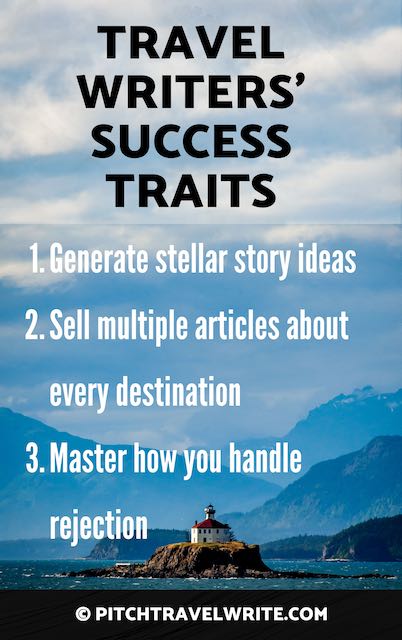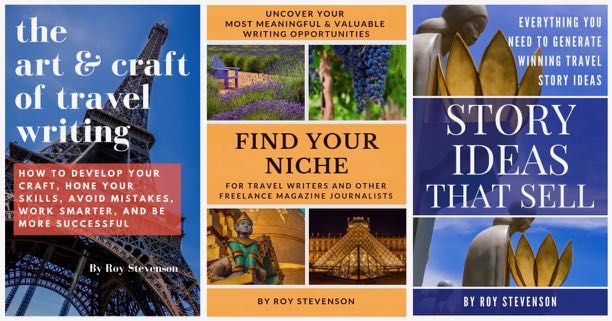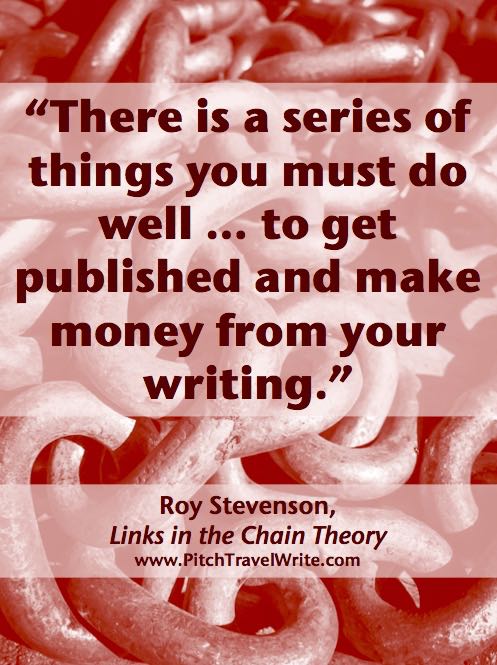- Home
- Getting Published
- Success Traits
Travel Writers' Success Traits
By Roy Stevenson
Travel writers' success traits include a combination of talents and skills. It's not rocket science, but it's also not easy to sell your stories to paying print magazines.
Every week I receive “The Question” from aspiring travel writers: “What does it take to get my travel stories published in print magazines, and get paid for them?”
There’s no one single answer. There’s no magic bullet.
As you might expect, skills and talents vary tremendously from one writer to the next. And for each individual, the depth of these skills and talents also varies greatly.
Writers need to figure out their strengths and weaknesses. Leverage your strengths and figure out how to deal with your weaknesses.
For example, there’s no point in working on improving your basic writing and grammar skills if your marketing and sales skills are poor. After all, if you can’t sell your stories, you don’t get to write them.
Similarly, if your sales skills are good, but your writing is poor, editors will reject your stories and won’t even read your query letters.
Some travel writers easily manage to get dozens of their stories into regional, national, or international magazines. Others struggle to get one or two stories published each month.
What’s the difference between these two groups? Travel writers success traits boil down to just a few things.
If success is defined as getting published, getting paid, and scoring those cool all expenses paid press trips to exotic places – here’s what I think those traits are:

Success Trait #1:
Generate Stellar Story Ideas
Always be looking for what makes a place unique, because that’s your story angle right there. Admittedly, this success trait comes with experience. I can’t count how many times I’ve seen an attraction or destination and got that nice warm feeling that screams out to me, “this is a highly saleable story”. Successful travel writers have developed this skill practically as a sixth sense.
When I measure whether a story idea has the potential to sell, in my mind I often see something that looks like a thermometer. This image is always accompanied by a percentage figure, like 60%.
This percentage figure is my indicator of what chance I have of selling this story to a magazine. I pitch the travel stories with high percentage figures. And this weird, highly instinctive, assessment system has never let me down. If I had to list my travel writing super power, this would be it.
What happens to the story ideas that my instincts tell me have a low percentage rating?
I stick them in my back-burner file. Eventually there may be an opportunity to sell these stories.
How do you recognize good travel stories?
- Keep your eyes open and be observant at your destination. Successful travel writers look for the underlying stories about the people, their culture, their quirks, and the reasons for their behaviors.
- What are the most interesting aspects of a place’s history?
- Pay attention to what you see, hear, smell, taste, and feel, around you.
- Look at each place and accept it for what it is. Travel stories and blog posts that constantly compare their destination with “back home” aren’t likely to make for good travel writing.
- Travel writers develop a healthy worldview. Celebrating the differences from your own culture makes good reading and helps readers (and editors) take your work seriously.
Success Trait #2:
Spinning a Destination Into Multiple Articles
Recognizing a good travel story is a valued skill for freelancers. The ability to sniff out travel stories to sell to numerous magazines under different guises is also important.
Why is it so desirable to sell multiple stories about one attraction or destination?
Re-selling, tweaking, or rewriting your travel articles is a far more efficient way to make money than the standard one-and-done approach.
Writing a single piece about a destination is not efficient or economical. By the time you visit a place, do your interviews, and then sit down and write your piece, it probably works out at a few dollars/hour.
Let’s say, for example, that you spend two days exploring a destination. Then it takes a full day to write it up. For a $500 payout, you’ll be paid $20.83/hour. And that’s before expenses!
If you get paid $250 for the same story, you’ll take home only half that amount, or just over $10 (before expenses)! Sad to say, you’ll make more working at a fast food franchise.
This explains why you want to spin every destination into multiple articles. In most occupations the maxim, “time is money” applies. It’s especially meaningful with travel writing.
Producing and selling multiple stories about a destination is the most profitable travel writers success trait. It enables you to earn more money for your time on the road.
Success Trait #3:
Successfully Handling Rejection
Rejection is one thorny issue for most freelance writers. The constant
rejection causes many aspiring writers to simply give up and walk away.
You can have all the basic skills to be very successful, but you won’t
be if you don’t learn to deal with the self-imposed demon of rejection.
Read
the biographies of many renowned authors like Stephen King, John
Steinbeck, and J.K. Rowling. You’ll notice their ascent to the top of
the writing pyramid was fraught with rejections. And so it is with
travel writing.
Freelance travel writers need to accept, and be
comfortable with, the fact that editors will reject their story ideas.
We can all expect our queries to sometimes disappear into an apparent
black hole. This will be especially prevalent with novice travel
writers figuring out how the whole thing works.

Even if you’re superbly talented, rejection will happen to you . . . in spades.
I’ve met plenty of writers who got off to a rocky start, with rejection after rejection. For some, it took one, or two, or even three years to break into better paying print magazines. But they kept firing out their queries and eventually struck pay dirt.
The ability to cope with rejection letters may be the most critical travel writers success trait you can master if you're a new writer.
Psychology professor, Dean Simonton, in his book “Origins of Genius”, examined the personality traits of highly successful creative people. He wanted to find out what exactly made them so successful. While most good artists have talent, discipline, creativity and intelligence, the highly successful ones had a high threshold for failure. In other words, they’d figured out a coping strategy for rejection.
According to Simonton’s findings, unsuccessful artists tend to give up sooner. They approached their work with more fear and apprehension which, in turn, held back their creativity.
This travel writers success trait means you need to devise your own personal approach to handling rejection.
What’s my coping strategy? It’s simple: I don’t feel a thing.
I don’t wring my hands in anguish that my genius has been rejected. I don’t curse the editor for not recognizing my phenomenal talent and failing to commission my work. I don’t even feel a sting to my ego. None of that.
I simply read the rejection letter (email) and glean anything useful from it for future reference. Then I keep on pitching more story ideas.
Where did I learn this skill? One day I was talking with a car salesman who said if he took every rejection personally, he’d have committed suicide a long time ago. Instead, he considers every rejection as bringing him a step closer to his next sale. Brilliant!
Break into Travel Writing
with the Creative Pack
The Creative Pack includes 3 eBooks that are the starting point for every travel writer: dreaming up unique story ideas that you can sell, finding the best writing niches for you based on your interests, passions and experience, and the art & craft of travel writing. They’re the pieces of the puzzle that come before you ever write a query letter to sell your articles to magazine editors.
If you're just getting started in travel writing, this group of resources will help you improve your craft, generate story ideas that sell, and develop your own unique and meaningful niche.
These eBooks can be purchased separately, but when you buy the bundle you'll save more than 10% off individual prices! Learn more here ...

Roy Stevenson is a professional travel writer and the author of www.PitchTravelWrite.com. Over the past ten years, he’s had more than 1000 articles published in 200 magazines, trade and specialty journals, in-flights, on-boards, blogs and websites and has traveled on assignment around the U.S. and to dozens of international destinations.
IF YOU ENJOYED THIS POST, GET UPDATES. IT'S FREE.

















